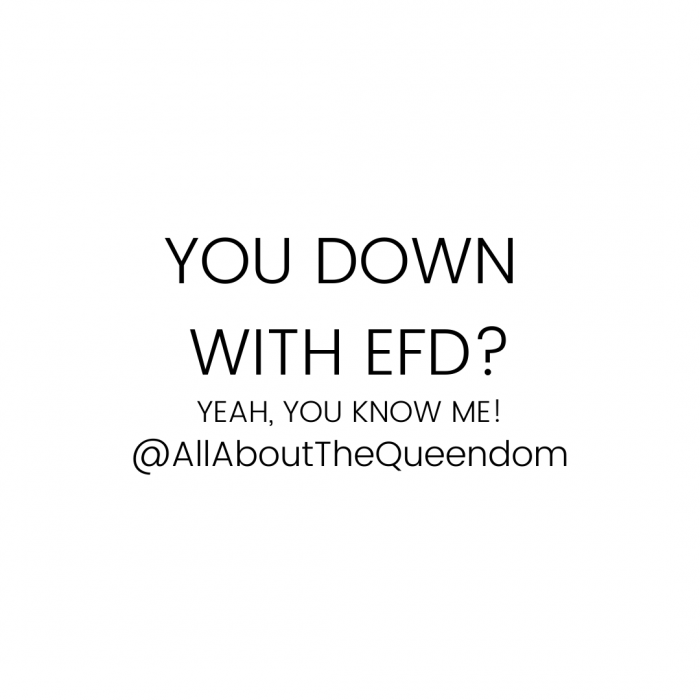…forgive the 90s throwback title.
Lady Queens, sometimes we feel so full of something intangible but also very real. Like we’re full of all of the things but have a hard time picking them apart. It’s usually a fusion of emotions, feelings, and desires, and it takes time to figure out which is which.
We’ve found it helps to know the difference between emotions, feelings, and desires as well as knowing the relationship between all three.
Let’s break it down: EFD – Emotions, Feelings, and Desires:
Emotions are body-based – we feel them in our bodies.
~
Best way to to keep your core pelvic and org@sm muscles strong and resilient? Here’s the coveted apparatus that makes this possible >>
~
Feelings are what the mind perceives about the emotions.
Desires are our deepest longing and womb wisdoms.
We’ll get more into desires at a later date – for now, let’s focus on the first two:
Emotions are natural and immediate physical responses after an experience. Feelings are our beliefs, associations and reactions to our emotions. And guess what? We have a choice in how we feel.
Example:
I feel hurt about what happened – I am angry because I believe I didn’t deserve it.
or
I feel touched by what happened; I see how this will serve me in the long run.
The way we process also applies to pain in our physical body. It’s how we allow it to flow through us, and rather than resist it, we can relax and ease out of pain, so it subsides faster and easier. We are in complete control and can set those boundaries with our own bodies. The more attuned we are to ourselves, the easier things are inside and out.
Teany: I did this with my ovulation and menses pains by allowing them through, versus medicating or ignoring. I witnessed a mix of pain/discomfort/emotions that came up during ovulation. Instead of muting the pain with drugs, I chose to become present with the feelings and brought my attention to it. As I did this, the pain started to dissipate and tension in the area relaxed. From this came a delicious sense of peace, ease and release. It was a new way of being present to these times of the month which added up over time to where pain is now practically non-existent. It was a big transformation for me.
Savannah: I’ve been working with clients, supporting them releasing their bodies, for over two decades. I’ve seen that through pain comes an opening and surrender that’s positive and liberating. Pain, knots and especially chronic muscular conditions are, in some circles, thought of as signs of emotional baggage. I’ve seen clients cry, scream, see things, revisit feelings, etc., during or after bodywork and certainly feel relief every time the work is done. Even discussing what’s going on in their lives can relieve months or even years of body pain or trauma.
I was in a major accident where a lorry went into the back of my car. Whilst I’m thankful to say I walked away from the experience with only a few bumps and muscle tears, for the first few days of driving again I was very anxious about lorries on the road, understandably. However, after three hours of body work on the affected area, that anxiety disappeared. Freeing trauma from the body as soon as it happens, especially when you’re afraid, can be a powerful factor in healing your feelings and changing the thought process or story you tell yourself.
Shifting our physiological state is like getting over jet lag: we go from being in a bit of a fog to being present – which is one of the reasons it’s so powerful for us as Queens to get body work. It can help support our physical and emotional release. Experiences that feel unpleasant or uncomfortable are powerful to go INTO, rather than run from. Restricting, medicating or ignoring the feelings, in fact, does harm. They get stuck in our bodies, so we still must deal with them later – they can even end up growing. Why? Because those emotions want to be listened to and addressed.
This subject is so juicy in that we as women have the capacity to be much more in tune with our feelings and emotions, something we may love or hate about ourselves: it’s important that we process our feelings and emotions, rather than distract, ignore, over-indulge in them, or push them away completely. Learning how to ‘identify’ and ‘digest’ our emotions and feelings more effectively will only serve us.
If we want to feel deliciously nourished by life and our expression in the world, then we must make sure we’re connected to and conscious about our EFD.
How?
One of the best ways we’ve found is by journaling our experiences, the thoughts and feelings we have about them, so we can better process them.
This will allow us to be open, conscious and bold with our emotional connection.
And open, conscious, and bold is a Queenly way to be!
Ready to join?
Hey, thanks so much for reading! Elephant offers 1 article every month for free.
If you want more, grab a subscription for unlimited reads for $5/year (normally, it's $108/year, and the discount ends soon).
And clearly you appreciate mindfulness with a sense of humor and integrity! Why not join the Elephant community, become an Elephriend?
Your investment will help Elephant Journal invest in our editors and writers who promote your values to create the change you want to see in your world!
Already have an account? Log in.
Ready to join?
Hey, thanks so much for reading! Elephant offers 1 article every month for free.
If you want more, grab a subscription for unlimited reads for $5/year (normally, it's $108/year, and the discount ends soon).
And clearly you appreciate mindfulness with a sense of humor and integrity! Why not join the Elephant community, become an Elephriend?
Your investment will help Elephant Journal invest in our editors and writers who promote your values to create the change you want to see in your world!
Already have an account? Log in.
Ready to join?
Hey, thanks so much for reading! Elephant offers 1 article every month for free.
If you want more, grab a subscription for unlimited reads for $5/year (normally, it's $108/year, and the discount ends soon).
And clearly you appreciate mindfulness with a sense of humor and integrity! Why not join the Elephant community, become an Elephriend?
Your investment will help Elephant Journal invest in our editors and writers who promote your values to create the change you want to see in your world!
Already have an account? Log in.

 Share on bsky
Share on bsky







Read 0 comments and reply